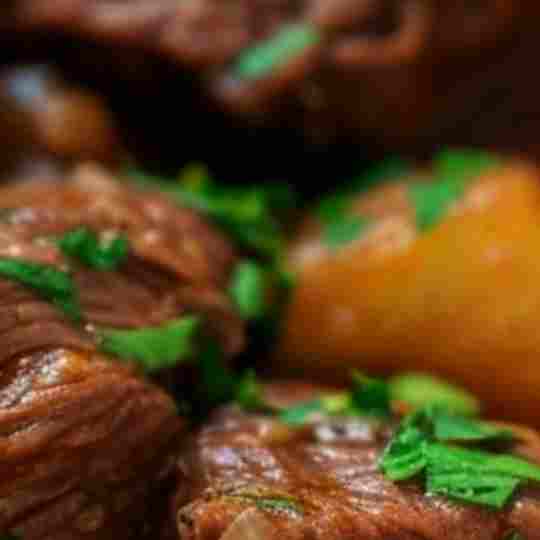the realm of hearty and comforting fare, the Slow Cooker Irish Poor Man’s Beef Stew stands as a beacon of culinary warmth and simplicity. This humble yet satisfying dish is a testament to the art of slow cooking, allowing flavors to meld and textures to reach sublime tenderness over an extended period.
As the slow cooker works its magic, the robust aroma of simmering beef, potatoes, and vegetables wafts through the air, creating an anticipation that lingers throughout the day. The beef, chosen for its economical and flavorful qualities, undergoes a slow and gentle transformation, gradually tenderizing into succulent morsels that melt in the mouth.
Amidst the medley of ingredients, potatoes take on a dual role, serving both as a hearty starch and as vessels for soaking up the savory broth. Carrots and onions contribute their own distinctive flavors, adding sweetness and depth to the stew. The symphony of herbs and spices, judiciously chosen and measured, weaves a tapestry of savory notes that harmonize with the slow-cooked beef and vegetables.
The broth, a rich elixir born of patience and time, envelops each component with its velvety embrace. Infused with the essence of the ingredients, the broth becomes a savory elixir that transports diners to the heart of Irish kitchens, where warmth and sustenance are one and the same.
As you lift the lid of the slow cooker, you are greeted by a sight that transcends the ordinary – a bubbling cauldron of flavors and aromas that promise a taste of home. The Irish Poor Man’s Beef Stew is more than a meal; it is a celebration of tradition, an homage to the enduring appeal of simple, well-crafted dishes that nourish the body and soul. Each spoonful is a journey into the heart of comfort, a reminder that sometimes, the most satisfying culinary experiences are born from the humblest of ingredients and the patient passage of time.
Ingredients:
– 2 lbs beef chuck, cut into 1-inch cubes
– 1/4 cup all-purpose flour
– 2 tbsp olive oil
– 2 large onions, chopped
– 4 cloves garlic, minced
– 4 large carrots, peeled and sliced
– 3 medium russet potatoes, peeled and cut into chunks
– 4 cups beef broth
– 1/2 cup tomato paste
– 1 tsp dried thyme
– 1 tsp dried rosemary
– Salt and pepper to taste
– 2 tbsp Worcestershire sauce
– 1 cup frozen peas
– 2 tbsp fresh parsley, chopped (for garnish)
Directions:
1. Toss the beef cubes with the flour until they are evenly coated. This helps to thicken the stew as it cooks.
2. Heat the olive oil in a skillet over medium-high heat. Brown the beef cubes in batches, ensuring a good sear for flavor. Transfer the browned beef to the slow cooker.
3. In the same skillet, add the onions and cook until they are translucent. Add the garlic and cook for an additional minute before transferring to the slow cooker.
4. Place the sliced carrots and potato chunks into the slow cooker with the beef and onions.
5. Pour in the beef broth, ensuring that the ingredients are well covered. Stir in the tomato paste, dried thyme, dried rosemary, salt, and pepper. Add the Worcestershire sauce for an extra depth of flavor.
6. Cover and cook on low for 8 hours or on high for 4 hours, until the beef is tender and the vegetables are cooked through.
7. About 30 minutes before serving, stir in the frozen peas. They’ll cook to perfection in the residual heat.
8. Once the cooking is complete, adjust the seasoning if necessary and serve hot, garnished with fresh parsley.
Variations & Tips:
– For those who like a bit of a kick, consider adding a pinch of cayenne pepper or some diced chili to the stew.
– A splash of good Irish stout can enrich the broth if you fancy a more complex flavor.
– If you’re looking to thicken the stew further, a cornstarch slurry mixed in during the last hour of cooking will do the trick.
– To make this stew even more budget-friendly, replace the beef with cubed lamb shoulder or even chicken thighs for a different twist on the traditional flavor.
– Lastly, don’t hesitate to experiment with additional root vegetables such as turnips or parsnips to enjoy the full spectrum of hearty flavors. Enjoy the process and the delicious results of this warm, comforting dish.
Enjoy!
